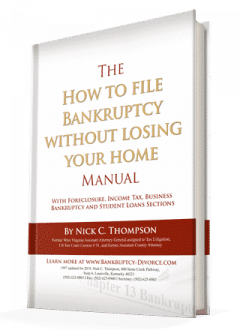Bankruptcy reaffirmation benefits a debtor by allowing the debtor to keep the property. But as Wells Fargo admitted at a trial reaffirming a debt does little to improve your credit. When you reaffirm, you continue to owe the bank after filing bankruptcy, and they report your on-time payments. But paying a debt after bankruptcy does not improve your credit based on the formula reporting companies use.
Reaffirmations are voluntary and drafted by the lender. The lender will send a reaffirmation to your attorney if you request it. Your attorney does not initially prepare them. The Debtor’s attorney only fills them out. You usually have to call the creditor and ask for the reaffirmation to be sent to your attorney. Reaffirmations must be signed within 15 days after the 341, or the property may be repossessed. There are three things to remember.
Bankruptcy Reaffirmations for Your Property
First, the reaffirmation must be signed and filed before the case closing. It is invalid if it is signed after the case closes. Second, reaffirmations can be filed after the case closes, but it costs another filing fee to reopen plus additional attorney fees. Third, if you have a negative budget with more expense than income, the court will not approve a reaffirmation. When your budget is negative, repayment would normally be an undue hardship. If your budget shows the item is an undue hardship, the reaffirmation will be denied.
The court has a reduced standard for looking over and approving home mortgages and credit union reaffirmations. Bankruptcy reaffirmations on auto loans, home mortgages, and boat loans are common. Most property is kept even if a reaffirmation is not signed as long as payments are made. But, the lender will not report the payments to a credit bureau.
⎆ Benefits and costs of a bankruptcy reaffirmation.
Bankruptcy reaffirmation benefits the lender. Lenders typically report the payments made to the credit bureau if you reaffirm. You can’t force the bank to reaffirm a loan. Often mortgage companies will not send out a reaffirmation. Reaffirmations can be vital if you wish to refinance a home mortgage later. The discharge will eliminate your responsibility for the debt, and only a reaffirmation returns you to owing for the debt.
It is my opinion that reaffirmation rarely benefits the debtor. You can voluntarily repay after bankruptcy. Banks won’t report on-time payments to credit bureaus unless you reaffirm. But if you reaffirm a debt, you could be sued for any deficiency later if you didn’t pay. When you owe too much for your car, consider filing a redemption or surrendering instead.
Reaffirmations have very little benefit to the debtor. Ford Motor Credit and Toyota are the only lenders which might repossess a car if there is no reaffirmation. Even they rarely force the issue unless you have been in default repeatedly.
Only reaffirm if you can afford it. Paying a reaffirmed debt on time after you file bankruptcy will help re-establish credit. Often the bank offering a reaffirmation might add attorney fees to the loan if you file a reaffirmation.
⎆ Redemption, reaffirmation, or surrender?
You have three options with your car or home after you file bankruptcy:
- If your car is unreliable and you owe too much, you can surrender your car or home in bankruptcy and owe nothing, which is an excellent way to get rid of a lemon auto. However, then you need another car or home. During Chapter 7 Bankruptcy, Budget Auto and Toyota of Louisville will finance an auto during a bankruptcy. Rates are high during bankruptcy, but their rates are better than the “buy here – pay here” option. If your auto is not reliable or is not worth more than the debt, now may be the time to exchange it!
- If you bought a reasonable car or house for a good price with a nice interest rate, you could keep it by reaffirming the debt and paying the lender as if you have never bankrupted that creditor. Most lenders will also allow you to make car and insurance payments on the auto to keep it.
- Redemption is when you pay the lender a lump sum for the replacement price of the auto, boat, or other personal property. The lender is then ordered by the court to release the lien, and you own the car free and clear. Then, some lenders will lend you the amount to refinance your car. However, 722 Redemption might save you money by allowing you to pay the car’s actual value and not what you owe. (1-888-721-2800) Also, if you have to surrender a vehicle, they may put you into a different car.
⎆ The time limits for the statement of intention.
In a Chapter 7 Bankruptcy, a debtor is required to sign a statement of intention, and you are supposed to redeem, reaffirm, or surrender within 15 days of your 341 hearing. You can change your mind and rescind a reaffirmation, but you have to revoke the reaffirmation within 60 days of filing it and, before discharge. You should send any rejection by certified mail. Reaffirmations allow the bank to repossess the car and to sue for nonpayment. For that reason I dislike most reaffirmations.
See 11 U.S.C. §521(a)(2)(B), §524(c)(6)(B) 11 U.S.C. §524(m)(2).
 Resources for Bankruptcy
Resources for Bankruptcy
Louisville Kentucky Bankruptcy Forms
Chapter 13 Auto Cramdown vs Chapter 7 Redemption • Video
How to Manage Your Car Loans in Bankruptcy
Chapter 7 Bankruptcy Auto Loan Redemption
If you are thinking about filing bankruptcy, don’t delay because timing is crucial. I am here to help you. So, contact my office right away to start the conversation. Nick C. Thompson, Bankruptcy Lawyer: 502-625-0905.

